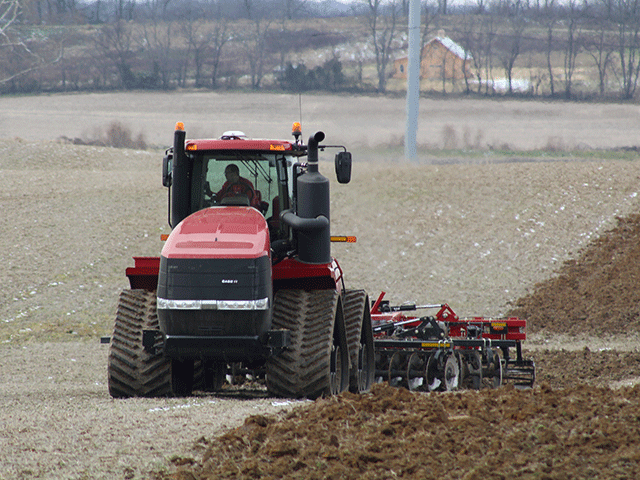Tillage Technology Breaks New Ground
Tillage Technology Can Improve Agronomic, Economic, Environmental Performance
ANKENY, Iowa (DTN) -- Tillage technology can help farmers produce a quality seedbed to boost yields and profit potential while improving soil health and protecting the environment.
That's the message two Case IH tillage specialists shared Tuesday during a 2021 Commodity Classic virtual learning session -- Agronomy Insights: Drive Profitability with Soil Management Systems and Technology.
Sensors that provide immediate feedback on the efficacy of a tillage tool so the operator can make adjustments on-the-go and tillage prescriptions that allow farmers to automate seedbed preparation based on agronomic and environmental conditions are two examples of tillage technologies available today.
Chris Lursen, Case IH tillage marketing manager, said advancements in soil management have opened up a new world to farmers to be more efficient and productive.
"The seedbed sets the stage when it comes to factors that contribute to yield," he said.
SEEDBED SENSORS
Seedbed sensors help create ideal planting conditions, according to Alison Bryan, Case IH tillage research agronomist. She conducts field trials to see how seedbed preparation can affect and improve corn yield and profitability.
Bryan said an uneven seedbed, which could be created by field cultivator shanks not staying at a consistent depth, can lead to planter row-unit bounce and inconsistent seeding depths. That can create different "microclimates" for seeds in the ground. Some seed could benefit from more heat and moisture and some may not, depending on seed depth. Inconsistent seed placement can affect germination and lead to uneven stands.
Case IH tillage research indicates a corn plant that is one growth or leaf stage behind its neighbor will yield 50% less. A corn plant 2 growth stages behind will yield 78% less compared to corn that emerged on time.
P[L1] D[0x0] M[300x250] OOP[F] ADUNIT[] T[]
"If that is happening enough in your field, it will be an issue," Bryan said. "The (corn plant) that did come up on time will not be able to compensate enough for plants that are behind."
That's where the value of seedbed sensing technology pays off, Lursen said. For example, he said sensors mounted on a Case IH Tiger-Mate 255 field cultivator monitor shank movement, or if they trip, as they cut through the soil. AFS (Advanced Farming Systems) Soil Command seedbed sensors relay that information in real-time to the display in the cab of the tractor. It allows farmers to measure and optimize the agronomic quality of the seedbed, according to the company. Farmers can make adjustments to eliminate the presence of an uneven seedbed floor that can cause a planter row unit to bounce.
Corrective measures could include adjusting speed, implement tire pressures and making sure cultivator wings are level with the main frame.
Just because the field surface looks smooth, Lursen said that doesn't mean the same goes for the seedbed floor. Sensors can detect that.
"You want a smooth seedbed floor for seed placement and depth consistency," Bryan said.
Case IH recently studied how corn yields were influenced by planter ride quality and tillage seedbed readings. A Tiger-Mate 255 field cultivator equipped with seedbed sensors worked up a 50-acre field of soybean stubble in central Illinois in May of 2020. No adjustments were made to the cultivator as it tilled the field. Seedbed quality readings were gathered. Corn was seeded with a high-speed planter.
The study indicates planter ride quality ranged from 90% to 94%. The higher the percentage correlates to a smoother seedbed floor.
Corn yields ranged from 226 to 238 bushels per acre (bpa) in the test field. For every 2% increase in planter row unit ride quality, yields increased by 6 bpa, according to results.
Lursen said even a 2-bushel increase over 1,000 acres of corn at $4 per bushel is an extra $8,000 in a farmer's pocket. He added that AFS Soil Command costs about $4,500.
He asserted seedbed sensing technology gives farmers "peace of mind" that they are creating a quality seedbed that complements the planter, which will likely result in a financial gain.
PRESCRIPTIVE TILLAGE
Case IH and John Deere offer automated, prescriptive tillage technology. Read about the growing trend of farmers implementing the practice and how it works here: www.dtnpf.com/agriculture/web/ag/magazine/your-farm/article/2021/01/01/cover-story-groundbreaking.
Lursen said writing and implementing variable rate seeding or fertilizing prescriptions isn't new to agriculture, but that's not the case when it comes to soil management.
Case IH released AFS Soil Command prescriptive tillage technology late last year. Lursen said farmers or their trusted advisers utilizing the technology will be able to write and upload tillage prescriptions this spring via AFS Connect software.
Tillage prescriptions are written and uploaded to a tractor's computer, which automatically adjusts a tillage tool's settings as it moves across the field. This could include the depth of shanks and disks, the gang angle of disks and downpressure of wings and rolling baskets.
The prescription could call for aggressive settings in areas of a field to alleviate compaction or to slice, dice and incorporate residue. In highly erodible areas of fields or areas with rocks, the prescription could adjust the tillage implement to be less aggressive or not engaged at all.
"This is exciting, head-turning technology," said Lursen, who also farms in northeast Iowa. "Prescriptions allow us to farm differently ... tailor tillage to the needs of the field."
Matthew Wilde can be reached at matt.wilde@dtn.com
Follow him on Twitter @progressivwilde
(c) Copyright 2021 DTN, LLC. All rights reserved.




